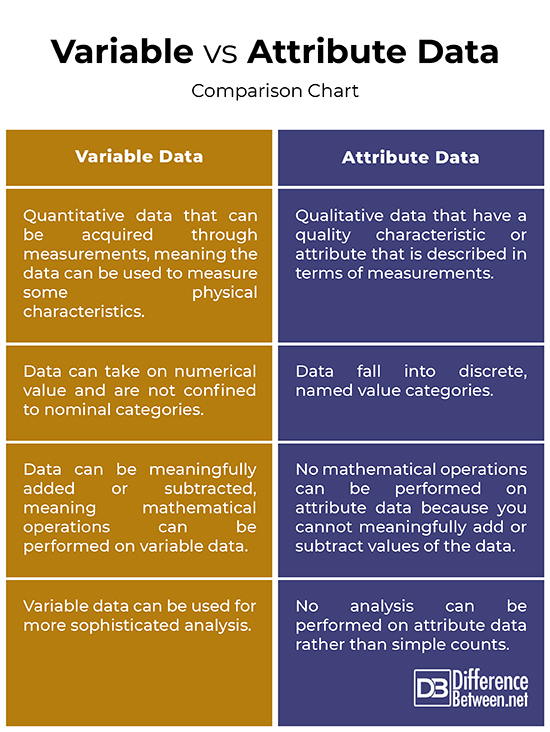Difference Between Variable and Attribute
Not all data are created equal. So, before you can do much else, understanding the types of data and how to use them is always imperative. Just as knowing about your opponent tells you which technique to use against them, knowing what kind of data you are dealing with tells you specifically which tools you should use. So, it is important to assess what type of data you have. In quality control, two types of data are mainly used to measure the quality of an item – Attribute data and Variable data.

What is Attribute Data?
Some data are qualitative data with a quality characteristic or attribute that are described in terms of measurements. These data can be classified and counted. This category of data is called attribute data. These data are described qualitatively in terms of dimensions, weights or other attributes that meet or do not meet product specification. Attribute data are all around use. For example, telephone area codes, clothing sizes, pass or fail assessment; all these can be called attribute data. These data clearly define whether a product achieves conformance, either it does or it doesn’t. For example, if it is supposed to rain today, either it will or it will not. It’s like a ‘Yes’ or ‘No’ scenario, meaning it is either Yes or No. So, attribute data is something that can be measured in terms of numbers or can be described as either yes or no for recording and analysis.

What is Variable Data?
If you can meaningfully add or subtract values of the data, then you are working with what is called variable data or continuous data. The name continuous refers to the idea that this type of data can have any value from a continuous scale, like the temperature reading on a mercury thermometer. Variable data is data that is used to measure some physical characteristics such as length, width, temperature, time, strength, thickness, pressure, and so on. These are quantitative data that can be acquired through measurements. For example, the number of children in a house can only be an integer value, like you cannot have 1.5 or 2.3 children in a house; you can only have 1 or 2 children. So, you can take integer measurement from each household and perform some sort of mathematical calculations such as derive an average or standard deviation from the data. This is what sets variable data from attribute data.
Difference between Variable and Attribute
Definition
– Variable data is quantitative data that can be acquired through measurements, meaning the data which can be used to measure some physical characteristics such as length, width, temperature, time, strength, thickness, pressure, and so on. Variable means the measured values can vary anywhere along a given scale. Attribute data, on the other hand, is qualitative data that have a quality characteristic or attribute that is described in terms of measurements. Attribute data is something that can be measured in terms of numbers or can be described as either yes or no for recording and analysis.
Nature
– Variable data is data that can be meaningfully added or subtracted, meaning you can perform mathematical operations on variable data. For example, by counting the number of children in each household in a particular area, you can calculate the average or standard deviation from the data. Being able to perform mathematical operations on the data is what sets variable data from attribute data. On the contrary, you cannot perform any mathematical operations nor do any kinds of analysis on attribute data. Attribute data can only be counted or can be said yes or no to.
Examples
– Attribute data is all around us. For example, telephone area codes, clothing sizes, pass or fail assessment; all these can be called attribute data. In quality control, a product goes for inspection can be either defective or not. There are only two possible outcomes for a product. Attribute data can be categorized as count type and yes or no type. Examples of variable data include the temperature reading in a mercury thermometer, GPA scores of all the students in a school, the amount of money you spend on shopping, the gas mileage of your car, the density of the liquid, height of a pillar, length of a road, or anything that has a value.
Variable vs. Attribute Data: Comparison Chart

Summary
In a nutshell, variable data is data in which quality is described quantitatively in terms of dimensions, weights, or other characteristics whereas attribute data qualitative data that have a quality characteristic or attribute that is described in terms of measurements. Although, attribute data is very important is stating that you have fulfilled the customers’ requirements, you cannot essentially any sort of analysis on attribute data than simple counts, unless you convert attribute data into variable data. Variable data are more flexible because you can perform mathematical operations of the data in order to perform a more thorough analysis on the data. Variables usually require smaller samples than attributes.
- Difference Between Caucus and Primary - June 18, 2024
- Difference Between PPO and POS - May 30, 2024
- Difference Between RFID and NFC - May 28, 2024
Search DifferenceBetween.net :
Leave a Response
References :
[0]Gygi, Craig et al. Six Sigma For Dummies. New Jersey, United States: John Wiley & Sons, 2010. Print
[1]Rizvi, S.A.H. et al. Quality Control (For Engineers and Managers). New Delhi, India: Galgotia Publications, 2004. Print
[2]Webber, Larry and Michael Wallace. Quality Control For Dummies. New Jersey, United States: John Wiley & Sons, 2011. Print
[3]Image credit: https://commons.wikimedia.org/wiki/File:HTML_Attributes_Table.png
[4]Image credit: https://commons.wikimedia.org/wiki/File:Variable_example.jpg
